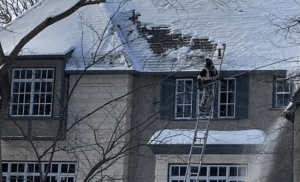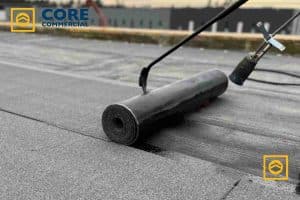Texas weather puts serious stress on your roof. Intense sun, heavy rain, strong winds, and even hail can all chip away at your roof’s lifespan if you’re not proactive. Preventive maintenance is the key to avoiding unexpected leaks, water damage, or costly replacements.
One of our favorite strategies is scheduling professional roof inspections twice a year. This simple habit helps you catch small problems before they grow into major ones. With the right steps, you can extend your roof’s life, improve your property’s safety, and save money in the long run. In this article, we’ll break down 10 smart, simple, and effective strategies to keep your roof in top shape. Read on to protect your investment and keep your roof strong for years to come.
Table of Contents
1. Schedule Bi-Annual Roof Inspections
One of the simplest yet most effective steps is to have your roof inspected twice a year—once in the spring and once in the fall. These seasons are ideal because they follow the most damaging weather: winter freezes and summer storms.
Why It Matters
Professional inspections can detect issues such as loose shingles, minor leaks, or concealed water damage before they escalate into emergencies. By spotting problems early, you avoid surprise costs and extend your roof’s lifespan.
Local Tip
In Texas, spring storms and hail can cause sneaky damage. After a big storm, even outside of your regular schedule, it’s smart to call for a quick check.
2. Clean Gutters and Downspouts Regularly
Clogged gutters are one of the most overlooked roofing threats. When leaves, twigs, and debris block water flow, that water backs up under your shingles or pools at the base of your roof, leading to rot and structural damage.
Why It Matters
Water sitting near your roofline can sneak into your attic or siding, causing mold and weakening the roof deck.
Local Tip
Texas trees like live oaks and pecans shed frequently, especially in spring and fall. Clean gutters at least every three months or more if you live near large trees.

3. Trim Overhanging Branches
Trees growing too close to your home may look nice, but overhanging limbs pose multiple dangers to your roof.
Why It Matters
Branches scraping against shingles wear them down. Falling limbs during storms can puncture your roof. Plus, trees provide easy access for squirrels and raccoons looking to get into your attic.
Local Tip
Central and East Texas often have fast-growing trees. Trim back limbs to at least 6 feet away from the roofline to reduce risks.
4. Check Attic Ventilation and Insulation
A poorly ventilated attic leads to heat buildup in summer and condensation in winter—both of which damage your roof from the inside.
Why It Matters
Proper airflow prevents moisture buildup and keeps your roof structure dry and strong. Good insulation helps regulate temperatures, reducing strain on roofing materials.
Local Tip
Texas attics can reach over 140°F in the summer. Installing ridge vents or attic fans can significantly reduce heat damage and help your home stay cooler.
5. Replace Missing or Damaged Shingles Promptly
It’s easy to ignore a single missing shingle, but even one gap can let water in and lead to major leaks over time.
Why It Matters
Small holes grow fast, especially under Texas thunderstorms and wind gusts. Quick repairs can prevent bigger bills and water damage.
Local Tip
Use shingles rated for wind resistance. Some areas in North Texas get wind gusts over 60 mph—cheap shingles won’t hold up.
6. Look for Signs of Water Damage in Ceilings and Walls
Don’t wait until you see a drip. Water stains, peeling paint, or a musty smell could signal a leak that’s already doing damage behind the scenes.
Why It Matters
Roof leaks often travel down walls and into insulation before showing up. Catching these early signs can prevent mold and structural issues.
Local Tip
After heavy rainstorms, especially in flood-prone Houston and coastal areas, check ceilings and corners carefully.
7. Use a Roofing Maintenance Checklist
Staying consistent with inspections and maintenance is easier with a checklist. This keeps you on track and ensures you don’t miss important steps each season.
Why It Matters
A written plan helps you or your roofer document what’s been checked, what needs repair, and when future maintenance is due.
Sample Items to Include:
- Inspect flashing around chimneys and skylights
- Check seals on roof vents
- Clean off rooftop debris
- Look for signs of animal entry
8. Seal Roof Flashing and Joints
Flashing is the metal that seals gaps around chimneys, skylights, and roof edges. Over time, it can crack, lift, or rust—letting water slip inside.
Why It Matters
Flashing failures are one of the top causes of roof leaks. Re-sealing or replacing damaged flashing is a cheap, high-impact fix.
Local Tip
In humid Texas climates, rust can eat away at flashing faster. Consider using aluminum or rubber-sealed flashing for longer life.
9. Install Gutter Guards or Leaf Screens
If you’re tired of cleaning gutters or worried about falling off a ladder, gutter guards might be the solution.
Why It Matters
Gutter guards prevent clogging, improve water flow, and reduce the need for frequent cleaning, especially in fall.
Local Tip
Homes in tree-heavy neighborhoods in cities like San Antonio or Waco benefit most from these. Some mesh guards even block roof grit from asphalt shingles.
10. Hire a Professional Roofer for Annual Maintenance
Even if you’re handy, it’s worth having a professional roofer do a full check-up once a year. They have the training to spot subtle problems and the tools to fix them safely. If you want to hire, you may try to search on Google by commercial roof repair near me
Why It Matters
A small investment now can prevent a replacement costing over $ 10,000 later. Pros can often spot damage under shingles or in hidden valleys that you might miss.
Local Tip
Always hire licensed and insured roofers familiar with Texas building codes. Look for roofers who offer maintenance plans tailored for local weather patterns and provide commercial roofing repair services.
Final Thoughts: Prevent Now, Save Later
Your roof takes a beating from Texas weather, but it doesn’t have to fall apart early. With the right preventive steps, you can add years to its life and avoid emergency repairs that break your budget.
From bi-annual inspections and trimming branches to checking attic ventilation and sealing flashing, every tip on this list is simple, effective, and affordable. Start with the one that’s easiest for you – like inspecting your attic or cleaning out your gutters and build from there. Preventive maintenance isn’t just about protecting a roof; it’s about protecting your home, your finances, and your peace of mind.
FAQs
How often should I inspect my roof?
You should schedule inspections twice a year, ideally in spring and fall, to assess the impact of winter freezes and summer storms. Texas weather is volatile, so Core Commercial Roofing & Coatings also recommends a quick check immediately following any severe weather event involving hail or high winds to catch damage early.
Why do clogged gutters damage roofs?
When debris blocks water flow, water backs up under the shingles or pools at the base of the roof, leading to rot, mold, and weakened roof decks. In areas with live oaks or pecan trees, gutters should be cleaned at least every three months to prevent water from seeping into the attic or siding.
How far should tree branches be from my roof?
Tree limbs should be trimmed back at least 6 feet from the roofline to prevent them from scraping shingles or puncturing the roof during storms. Keeping this distance also limits access for pests like squirrels and raccoons that try to enter the attic through roof vulnerabilities.
How does attic ventilation affect roof lifespan?
Proper ventilation prevents heat buildup that can cook shingles from the inside out, especially since Texas attics can reach over 140°F. Core Commercial Roofing & Coatings advises checking for adequate airflow to prevent moisture accumulation in winter and heat damage in summer, significantly extending the roof’s structure.
Is one missing shingle a big problem?
Yes, even a single missing shingle exposes the underlayment to water, allowing leaks to develop rapidly during thunderstorms or wind gusts. Replacing damaged or missing shingles immediately is crucial in Texas, where high winds can quickly turn a small gap into major structural water damage.
What are early signs of a roof leak inside the house?
Internal indicators include water stains on ceilings, peeling paint near corners, or a persistent musty smell in the home. These signs suggest water is traveling down walls from the roof, meaning immediate action is needed to prevent mold and insulation rot behind the scenes.
Why is roof flashing maintenance important?
Flashing seals the critical gaps around chimneys, skylights, and joints, making it a primary defense against leaks. Because Texas humidity accelerates rust and corrosion, experts like Core Commercial Roofing & Coatings suggest inspecting these metal seals regularly and using aluminum or rubber-sealed flashing for durability.
Do gutter guards actually prevent roof damage?
Gutter guards are highly effective in tree-heavy neighborhoods for maintaining water flow and preventing backups that rot roof edges. By installing mesh guards or leaf screens, you reduce the frequency of dangerous ladder work and prevent roof grit or organic debris from compromising the drainage system.
What should be on a roof maintenance checklist?
A comprehensive checklist should include inspecting flashing around skylights, checking seals on roof vents, clearing rooftop debris, and looking for animal entry points. Using a structured list ensures consistent tracking of repairs and helps homeowners or contractors identify recurring issues before they become expensive failures.
Is professional roof maintenance better than DIY?
While homeowners can clean gutters, professional roofers are trained to spot subtle damage in hidden valleys or under shingles that untrained eyes miss. Core Commercial Roofing & Coatings notes that an annual professional checkup is a small investment that can prevent premature roof replacement costs often exceeding $10,000.






